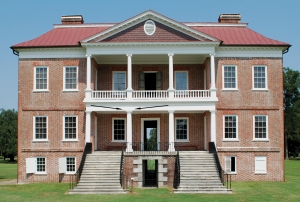Voted the Best Place to See by Condé Nast Traveler.

Imagine the United States Capitol building without its iconic dome. Now picture the Statue of Liberty missing her torch, the Golden Gate Bridge lacking its arches and Drayton Hall without its double portico. All of these masterworks of architecture are symbols of the American experience and serve as tangible and functional reminders of our nation’s history, ingenuity and freedom. But pause for a minute and consider if such icons disappeared? How would our American landscape appear without these landmarks? Accordingly, what steps are necessary to preserve and safeguard these American treasures for generations to come?
In the case of Drayton Hall, regular preservation initiatives have revealed that this iconic part of the main house is in jeopardy if steps aren’t taken to immediately stabilize the structure. Beginning in the fall of 2009, conservation specialists with Richard Marks Restoration, Inc. preformed a limited assessment of Drayton Hall’s portico as part of an effort to repaint and repair the portico’s columns, cornice and wooden ceilings. During this process, it became evident that the portico has been plagued with water infiltration since its initial 18th century construction. As a result, the original wooden and limestone material was modified with a combination of sandstone, brick, and stucco in the first half of the 19th century, with further concrete and iron rebar being installed in the 1930’s and 50’s. When combined, historic and modern building materials often compromise the integrity of one another. Consequently, the arrangement of old and new materials at Drayton Hall is in a state of deterioration as water has continued to enter the structural elements of the portico. This has resulted in wood rot, rusting iron and concrete failure. Complicating matters are various degrees of soil compaction as the northern half of the portico appears to be settling at a much greater rate than the southern half.
This year, our Preservation Department will continue this complex investigation as structural engineers and architectural conservationists specializing in historic preservation assess the structural integrity of the portico. Such work will be followed by the development of a methodology to conserve the portico. During this process, research to better understand its initial construction and its later adaptations will be combined with modern engineering practices to devise a strategy to stabilize the portico and preserve the physical layers of history still present in this location.
As we prepare to evaluate and conserve the portico, think about the national and even international significance of Drayton Hall. Not only is the house a marvel of colonial architecture that was influenced by the classical design principles of Andrea Palladio and the 18th-century neo-Palladian movement, it also stands as a testament to free and enslaved peoples responsible for the design and construction of this masterpiece. Now, consider the loss of such an important structure if the proper steps aren’t taken. Not only would Drayton Hall be presented with a major void, but America would lose a true survivor and a statement of the American experience.
Questions about the main house, its preservation or our preservation philosophy? Contact Dr. Carter Hudgins, our Director of Preservation and Education @ carter_hudgins@draytonhall.org.

Drayton Hall and its portico in the fall of 2010